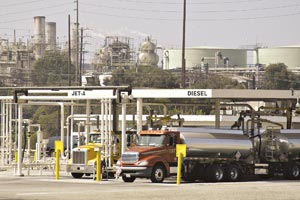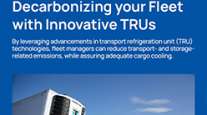California Expands Cap-and-Trade Program; Trucking Executives Expect Higher Fuel Costs

This story appears in the Jan. 12 print edition of Transport Topics.
California’s cap-and-trade program extended its reach to diesel fuel and gasoline on Jan. 1, creating no immediate price change but a great deal of concern about the workings over time of a highly complex system.
The California Air Resources Board, which administers cap and trade, projects that per-capita fuel costs will drop between now and 2035 as consumers benefit from technological innovation for vehicles and new types of fuel.
However, fuel and trucking industry executives predicted that cap and trade, when fully factored in by refiners, will add about
12 cents a gallon to retail diesel prices and 10 cents to gasoline.
“The real impact to end users will be a pretty significant pass through” of costs paid by refiners to truck and car operators, said Chris Shimoda, policy director of the California Trucking Association in Sacramento.
Cap and trade, in general, promotes environment-friendly policies by limiting emissions. The emissions allowance is strictly controlled and must not exceed the predetermined cap amount. Emissions permits are sold to businesses and are capped by government.
Climate change due to carbon dioxide emissions is an important issue, not just for CARB but also for the state’s governor, Democrat Jerry Brown, who was sworn in for a fourth term on Jan. 5.
The Associated Press led its coverage of Brown’s inaugural address with his climate-change remarks, saying that he “charted an ambitious new goal . . . for California in its fight against climate change, challenging the nation’s most populous state to increase renewable-energy use to 50% in the next 15 years,” or by 2030.
The current policy goal for renewable energy is 33% by 2020. AP reported the 2014 rate as 25%.
Cap and trade will affect trucking like a tax, even though it is not administered as one. Acting in response to a state law passed in 2006, CARB said it is working to get the state’s carbon emissions back to 1990 levels by 2020.
To do so, it is selling allowances to emit a metric ton of carbon — about 2,200 pounds — at auction. The most recent auction in November priced a metric ton at $12.10. The next quarterly auction will be on Feb. 18.
Over time, the agency said, it will auction off fewer allowances, meaning that less carbon will be emitted. That is supposed to serve as an incentive for the innovations the California government wants.
Cap and trade had been an issue for California companies since January 2013, but only for stationary sources of carbon such as oil refineries, electric power plants and many factories.
Fuel producers got an extra two years, but this will expand the program significantly. CARB estimates the transportation industry produces 40% of the state’s carbon emissions.
“The two big questions are: How much will this cost? And how will companies recoup the costs?” said Mike Tunnell, director of energy and environmental affairs for American Trucking Associations who works near Sacramento.
“California is the first state, the Petri dish, for this,” he said.
Wholesale fuel racks, the high-volume pumps that fill up tank trucks, are an important part of the program. Businesses that buy diesel or gasoline from the racks or later in the supply chain do not have to participate in the compliance process but probably will see price increases, eventually.
Oil refineries that deliver refined products to the racks or companies that buy before the rack have to buy allowances to emit from auctions or on the secondary market.
There was no immediate price increase for California diesel.
The U.S. Department of Energy said that from Dec. 29 to Jan. 5 the average for a retail gallon of California diesel dropped by 2.3 cents to $3.341 a gallon. Part of the reason for that is the 18-month lag for accounting and reporting, said Tupper Hull, a vice president of the Western States Petroleum Association in Sacramento. Allowances for first-quarter 2015 usage do not have to be forwarded to CARB until the third quarter of 2016, Hull said.
Auction proceeds are deposited in California’s Greenhouse Gas Reduction Fund for projects to develop high-efficiency vehicles and low-carbon fuels, and mass transit and other strategies for limiting energy use.
A December CARB report said November’s quarterly auction brought in $136 million, up from $98.7 million in the August auction. For the fiscal year ended June 30, the auctions generated $477.1 million, and the inclusion of transportation fuel is expected to swell that amount.
CTA’s Shimoda said he worries the program will crowd out the ability to raise traditional fuel taxes to pay
for much-needed infrastructure improvement. If fuel prices rise because of cap and trade, voters could become strongly opposed to raising fuel taxes, too. “It’s absolutely a concern of ours. We support diesel tax revenue being used for roads.”




